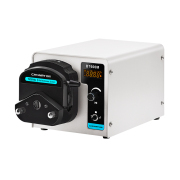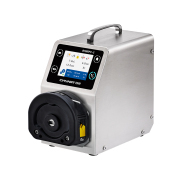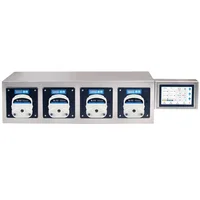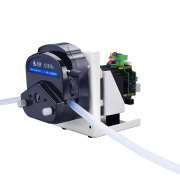Chonry Peristaltic Pump
Peristaltic Dispensing Pump
Peristaltic Dispensing Pump
The peristaltic dispensing pump has several features.peristaltic dispensing pump Its axial length is generally fixed, and it has a roller that can move up and down. The pump's occlusion is also fixed, but the percentage of occlusion varies depending on the tube wall thickness. The higher the percentage, the higher the wear on the pump and its tube life. Therefore, there are several restrictions in the axial length of the pump.
The motors and the pumps are equipped with remote controls for simple integration in an automated system and improved user comfort during repetitive dispensing. Remote control functions can include start, dispense, reverse, and prime. The speed can also be adjusted. The pumps' drive can be digital or analog. A variety of control accessories is available. These include foot switches and dispensing wands for momentary start/stop and full-function handheld remote controllers.
Another factor to consider is the length of the hose. As the peristaltic pump's hose is not linear, its flow rate changes as the hose fills. If the inlet pulsates at a high rate, the hose fills oval-shaped, and the flow is reduced. Constant flow rate is essential for accurate metering with a peristaltic pump.
The accuracy of the dispensing process is essential for drug development and delivery. High-potency compounds, such as bio-tech "designer molecules," are often expensive, and accurate dispensing is vital to their successful development. A high-quality, reliable pump must reduce the time to complete a process, while also maintaining product within the dispensing tube. This is where the peristaltic dispensing pump comes in handy.
Unlike other pumps, a peristaltic pump is easy to clean and maintain, thanks to the tubing's unique design. This type of pump is also ideal for pumping liquids and chemicals, such as a variety of foods, beverages, and condiments. Tubing capacity is fixed, but it will need to be periodically replaced. However, it can also be customized to meet specific needs. And Thomas engineers can help you find the right peristaltic pump for your needs.
During bypass surgery and heart-lung machines, the peristaltic pump circulates blood without causing hemolysis. It works by compressing the tube and trapping a body of fluid in between the rollers. The fluid is then transported through the tube towards the outlet of the pump. Some peristaltic pumps are continuous while others are indexed through partial revolutions. The benefits and drawbacks of the peristaltic pump are numerous.
A peristaltic pump is often used in laboratories and industrial production. Its high flow rate and precision dispensing make it an excellent choice for these applications. The pump's ABS plastic housing and touch screen controller ensure a streamlined, ergonomic design. It also features an intuitive touch-screen control, making it easy to use and operate. Its built-in controller allows it to store 60 commonly used filling modes.
Another peristaltic dispensing pump's benefits lie in its chemical compatibility. Its stiff plastic liner can degrade over time due to repeated flexing, rendering the bulk material vulnerable to chemical attack. This delamination is common, but it signals the end of the tube's useful life. Lined tubing can be used for applications where chemical compatibility is critical. This makes it a good choice for chemically-challenging processes.
0users like this.







